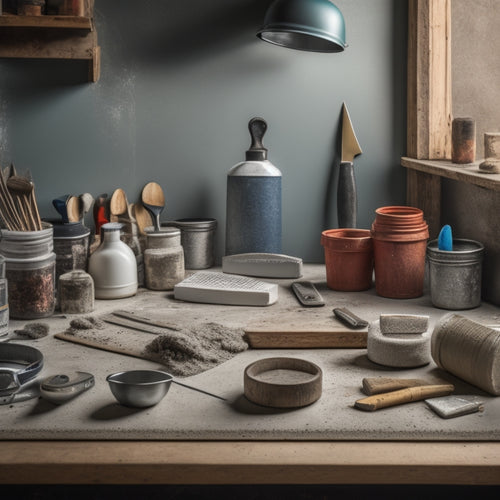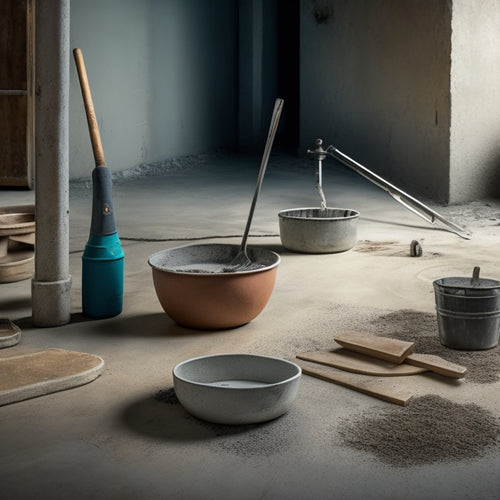
Top 3 Must-Have Tools for Concrete Refurbishment
Share
When refurbishing concrete surfaces, you'll need three essential tools in your arsenal. First, high-torque grinders are a must-have for effectively removing old coatings and adhesives. Next, dust extractors will keep your work environment clean and safe by capturing dust and debris. Finally, diamond abrasives are vital for achieving progressive surface refinement and a high-gloss finish. With these tools, you'll be well on your way to a successful refurbishment project - and there's more to explore about the process to guarantee you get the best results possible.
Key Takeaways
• High-torque grinders are essential for removing old coatings and adhesives effectively in concrete refurbishment projects.
• Dust extractors are must-have tools for maintaining a clean work environment and capturing dust and debris.
• Diamond abrasives in various grit levels are necessary for progressive surface refinement and achieving a high-gloss finish.
• Surface cleaning equipment, such as scrubbers and vacuums, are critical for removing contaminants and ensuring a strong bond between concrete and finish.
• Scarifiers are necessary for removing old coatings and adhesives from the surface, allowing for a smooth and even finish.
Polishing and Grinding Essentials
When refurbishing concrete, you'll need to stock up on polishing and grinding essentials, including high-torque grinders, dust extractors, and a range of diamond abrasives. These tools are vital for achieving a high-gloss finish and removing imperfections from the concrete surface.
High-torque grinders, for instance, provide the necessary power to effectively remove old coatings, adhesives, and other substances that may be hindering the polishing process. Dust extractors, on the other hand, are important for maintaining a clean and safe work environment by capturing dust and debris generated during the grinding process.
To master various polishing techniques, you'll need to have a range of diamond abrasives at your disposal. These abrasives come in different grit levels, allowing you to progressively refine the concrete surface to achieve the desired level of shine.
By investing in high-quality grinding equipment and diamond abrasives, you'll be able to achieve professional-grade results and transform dull, lackluster concrete into a stunning, high-gloss finish.
Remember to always follow proper safety protocols and operating procedures when working with these tools to guarantee a successful and safe concrete refurbishment project.
Concrete Floor Preparation Tools
Before you begin polishing and grinding, you'll need to prepare the concrete floor by removing dirt, oil, and other substances that may interfere with the bonding process, and that's where concrete floor preparation tools come in.
These tools are essential for ensuring a strong bond between the concrete and the desired finish.
Here are some must-have concrete floor preparation tools:
-
Surface cleaning equipment: This includes scrubbers, brooms, and vacuums that help remove dirt, oil, and other contaminants from the surface.
-
Moisture testing equipment: This is vital for detecting moisture levels in the concrete, which can affect the bonding process.
-
Scarifiers: These tools are used to remove old coatings, adhesives, and other substances that may be present on the surface.
- Grinding machines: These machines are used to smooth out the surface, removing any imperfections and creating a uniform finish.
Sealing and Coating Solutions
You'll need to apply a suitable sealing and coating solution to protect the refurbished concrete surface from stains, abrasion, and environmental elements. This vital step guarantees the longevity and appearance of your concrete refurbishment project.
When selecting a sealing and coating solution, consider the level of protection required, as well as the desired finish and aesthetic.
Epoxy finishes, for instance, offer a high-gloss, chemical-resistant coating suitable for industrial or commercial applications. On the other hand, waterproof sealers provide a clear, non-yellowing barrier against water and moisture, making them ideal for exterior or high-traffic areas. It's important to choose a solution that's compatible with the concrete substrate and suitable for the intended use.
Before application, verify the surface is clean, dry, and free of contaminants. Follow the manufacturer's instructions for preparation, application, and curing times to achieve a successful seal.
Frequently Asked Questions
Can I Reuse Concrete Refurbishment Tools on Different Projects?
When reusing concrete refurbishment tools on different projects, you'll need to ascertain tool compatibility and project adaptability, considering factors like surface preparation, material compatibility, and environmental conditions to guarantee effective results.
How Do I Store and Maintain My Concrete Tools?
'Are you willing to sacrifice your tools' longevity for convenience? You shouldn't. Properly clean and store your tools after each use, and maintain an organized system to extend their lifespan and guarantee peak performance on your next project.'
What Safety Gear Is Essential for Concrete Refurbishment?
When working on concrete refurbishment projects, you'll need essential safety gear, including protective equipment like hard hats, safety glasses, gloves, and steel-toed boots to prevent injuries from falling debris, chemical splashes, and heavy objects.
Can I Rent Concrete Refurbishment Tools Instead of Buying?
"Just like a master builder, you're wise to weigh your options. Renting concrete refurbishment tools can be a cost-effective solution, offering flexible rental options that help you reap cost benefits without breaking the bank."
Do I Need Specialized Training for Concrete Refurbishment Tools?
You'll likely need specialized training to operate concrete refurbishment tools safely and effectively, as training requirements vary by tool selection and project complexity, ensuring you understand proper techniques and equipment operation.
Conclusion
As you stand back to admire your refurbished concrete masterpiece, remember that the tools you wielded were the brushstrokes of a master artist.
The polishing and grinding essentials were the bold lines that defined the canvas,
the concrete floor preparation tools were the subtle textures that added depth,
and the sealing and coating solutions were the vibrant colors that brought it all to life.
With these three must-have tools, you've transformed a dull, worn surface into a work of art that will stand the test of time.
Related Posts
-

Essential Tools for Concrete Wall Covering Projects
When tackling a concrete wall covering project, you'll need a range of essential tools and equipment. For cleaning an...
-

Why You Need These Concrete Overlay Tools
When tackling a concrete overlay project, you need the right tools to achieve a flawless finish and avoid costly mist...
-

Why These Concrete Tools Are Always in Demand
You rely on a set of trusted concrete tools to deliver high-quality results, and it's not surprising - these tools ar...


